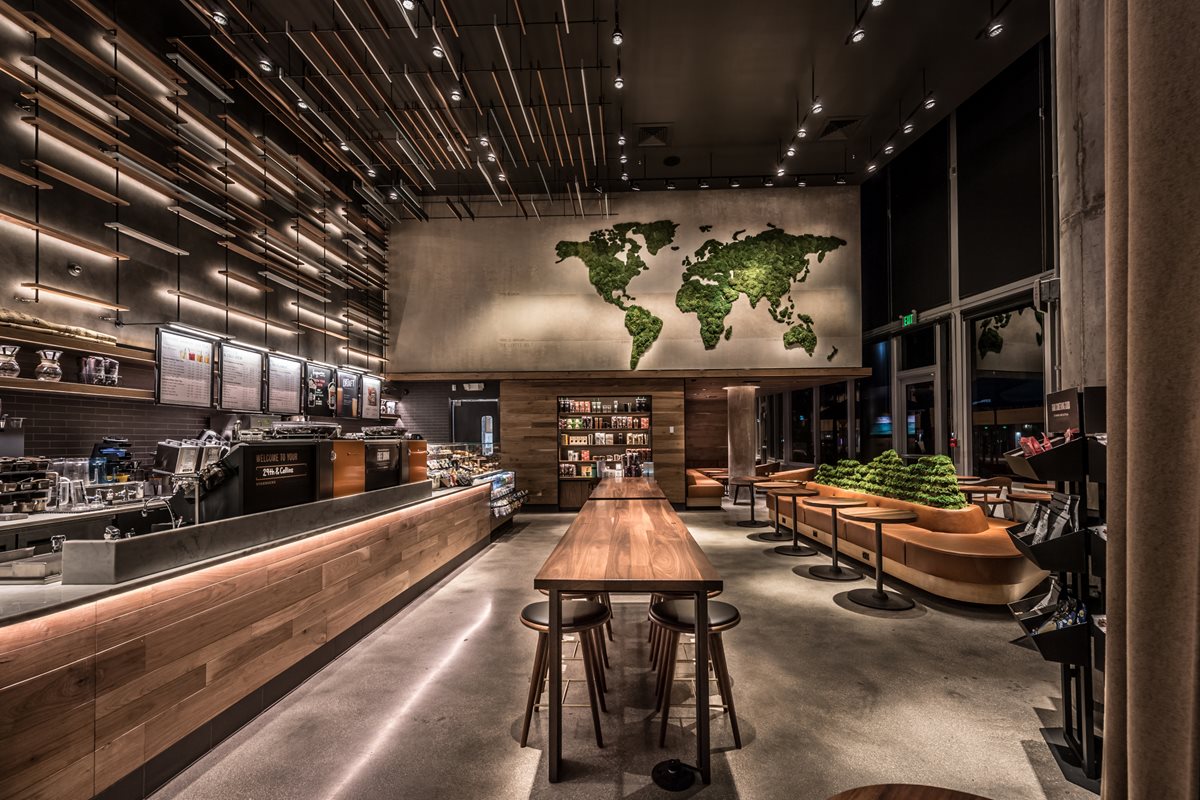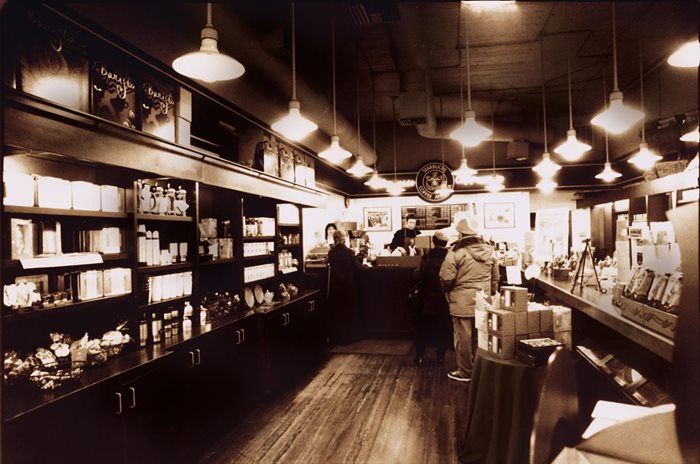In the third and final part of our Starbucks at 50 series we examine the Seattle-based coffee chain's efforts to reduce the environmental impact of its global store and supply chain network. We also explore the brand's use of technology in developing The Third Place concept and ask key industry experts what the coffee industry might look like if Starbucks had never arrived on the scene. Catch up on
part one and
part two here.
.jpg.aspx?lang=en-GB&width=700&height=469) Starbucks app-based Pickup format was introduced in 2020, and helped steer many stores through Covid-19 trading restrictions | All photos courtesy of Starbucks Coffee Company
Starbucks app-based Pickup format was introduced in 2020, and helped steer many stores through Covid-19 trading restrictions | All photos courtesy of Starbucks Coffee Company
A global footprint
Starbucks’ 33,000+ store footprint is supported by a vast international supply chain, drawing resources, expertise and logistics from across the planet. With such a mammoth operation comes a growing imperative for Starbucks to reduce its environmental impact.
Responding to this gargantuan challenge, in January 2020 Starbucks unveiled an ambitious roadmap to become a resource positive company by 2030.
Pledging a ‘scientific approach’ to achieving its goals, Starbucks partnered with sustainability consultancy, Quantis, to measure its environmental impact and the efficacy of its sustainability policies. As part of the pledge, the world’s largest coffee chain revealed it emitted 16 million tons of CO2, withdrew one billion cubic metres of water, and produced 868 kilotons of waste, including six billion disposable cups, across its global business in 2018.
By 2030, Starbucks is targeting 50% reductions across carbon emissions and waste sent to landfills from stores and manufacturing. It will also seek to conserve or replenish 50% of the water currently being used for direct operations and coffee production.
Given the scale of its operations, Starbucks clearly has a huge task ahead of it. The company is frequently challenged on how it reports progress from its sustainability and ethical programmes. Nevertheless, the scope of its ambition and efficacy of its positive impact – especially compared to similar-sized companies – is undeniably admirable, even if it is not infallible.
“The downside for Starbucks is that it has very much become the face of the whole of the coffee industry, and that means it often has to answer for all the things that are ascribed to the coffee industry. Starbucks frequently becomes the face of debates surrounding equity, homogenisation, globalisation and corporate ethics, even if the company itself is not necessarily the root of many of those issues,” observes Morris.
.jpg.aspx?lang=en-GB&width=700&height=466)
Starbucks has commited to designing, building and operating 10,000 greener stores globally by 2025
New ways of working
Starbucks has long had its finger on the pulse of global technology trends, becoming among the first retail brands to embrace in-store wi-fi, customer apps and mobile payment. In 2002, Starbucks launched wi-fi in its US stores, which was initially limited to two hours’ free usage and a $3.99 charge thereafter. The My Starbucks Rewards loyalty programme and first iPhone app with Starbucks Card mobile payment were introduced in 2009, and at the time were the largest combined mobile payments and loyalty programme in the US.
By 2010, when many coffee shops began taking umbrage with laptop laden customers, Starbucks further embraced The Third Place environment it pioneered with the creation of comfy in-store lounge environments. That year it introduced unlimited wi-fi in stores, and the following year launched the Starbucks Digital Network. The novel service included access to third-party digital news and sports content as well as an online section including tools for job searching or résumé writing.
“Starbucks introduced the concept of a space that is both a service space and a lifestyle space. That fits very well with our mobile society – you can go to a Starbucks store to meet friends or do your work. The concept of ‘The Third Place’ has completely transformed our notion of retail experiences and the high street. It has also transformed our notion of socialising – we used to invite people to our homes for coffee, now you meet people out for coffee,” says Morris.
Today, Starbucks is responding to the challenges of the Covid-19 pandemic and greater consumer desire for convenience and seamless in-store experiences. In 2020 it launched Pickup – a streamlined, digitally enabled store format revolving around mobile ordering, payment and delivery.
"The concept of ‘The Third Place’ has completely transformed our notion of retail experiences and the high street"
– Prof. Jonathan Morris, Coffee Historian
Indeed, there is evidence that Starbucks’ pivot towards seamless digital transactions risks becoming a victim of its own success. With mobile orders now making up to a quarter of Starbucks’ sales in the US, many of the chain’s baristas have reported surging mobile orders – often with voluminous and highly customised requests – leading to thick crowds of customers and longer waits for beverages.
Nevertheless, with seamless digital transactions already on the ascendent before Covid-19 struck, Starbucks’ continued focus on the digital coffee shop experience is a smart adaptation to the challenges of the post-pandemic marketplace, providing valuable lessons to the wider coffee industry on how to adapt and grow in times of adversity.
More than just a coffee shop
Love them or loathe them, it is difficult to ignore the prowess of Starbucks as a true pioneer of the coffee industry, and among the first to harness its global potential. From its roots at the dawn of the US specialty coffee movement, to its popularisation of the branded coffee shop format in the US and beyond, Starbucks has continually demonstrated its ability to innovate, adapt and evolve with the times.
“When Starbucks started in the 1970s, they weren’t copying anybody – they had their own mission and vision. They achieved something that no one else had done with coffee up to that point in time. I respect their global position for that – it has helped the global industry so much, made people passionate about coffee, and generated business opportunities that we have all benefitted from,” says Bakke.
 Interior of Starbucks’ first store at Pike Place, Seattle taken in 1981
Interior of Starbucks’ first store at Pike Place, Seattle taken in 1981
In championing coffee shops as a viable and profitable business model worldwide, Starbucks has also generated massive value and countless business opportunities. World Coffee Portal estimates the global branded coffee shop market revenue has increased more than 25-fold in the last two decades alone.
We’ll never know what the global coffee industry would look like if Starbucks had never arrived on the scene. However, it is likely there would have been substantially fewer opportunities for business growth, careers in coffee, and less product innovation.
“If Starbucks had never existed the global coffee industry today would be smaller and poorer,” says Kither. “They realised the potential of the coffee shop industry in those early days and that they could scale their business without cannibalising store sales. Starbucks made the coffee industry realise it could expand, and I don’t think it would have grown as much as it has without them.”
Whatever your opinion of Starbucks, the many waves of innovation left in its 50-year wake are clear for all to see. Today, the brand continues to be a powerhouse for new products, new store formats, and new ways of doing business. With coffee shop culture continuing its ascendancy globally, one can only marvel at the potential for Starbucks, and the global coffee industry, over the next 50 years.
For more on our series exlpring Starbucks's lasting impact on the business of coffee, tune in to a special episode of the podcast here.
This article was first published in Issue 7 of 5THWAVE magazine.
Subscribe to 5THWAVE to receive each edition in print and digitally or sign up to our newsletter and be the first to read the latest articles and updates on World Coffee Portal research
